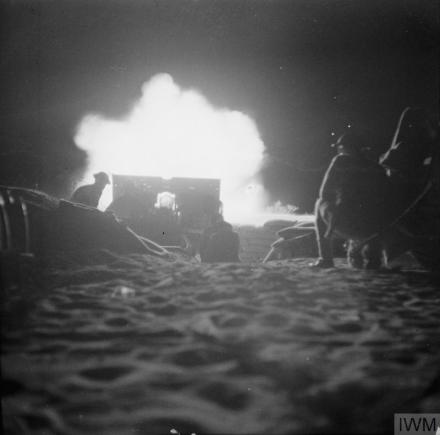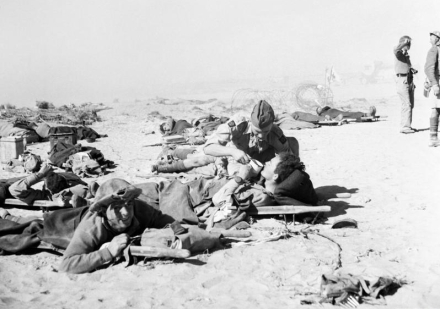
Lucas Majozi DCM
A very notable South African hero. The highest decoration awarded to a Black South African soldier during the Second World War was the DCM (Distinguished Conduct Medal) awarded to Lucas Majozi (1916-1969). Read on for the story of one of South Africa’s bravest.
Lucas Majozi volunteered to fight in the 2nd World War, however as he was a black man, race politics in South Africa dictated that he could only join the Native Military Corps (NMC) in a non-combat role, which meant he and all other South African ‘Bantu’ fighting in World War 2 could not carry a firearm – unlike the Cape Coloured Corps, which could carry firearms and take a combat role. This did not however keep the Native Military Corps away from the perils of fighting and NMC were often fight right in the middle of the fighting. To read up a little more of this, see Observation Post ‘Armed’ SA Native Military Corps in WW2 – this Corps screams out for a definitive work! .
So how does an unarmed NMC soldier get to win one of the highest accolades for bravery in World War 2?
The answer lies in Lucas Majozi’s personality and character, he was a proper South African warrior and although he would be unarmed he volunteered to become a medic working as a stretcher bearer in the thick of fighting to bring wounded men back from harm to aid stations, an extremely dangerous job. Like another Native Military Corps hero – Job Maseko, Lucas Majozi by his actions was also to become one of South Africa’s fighting legends. To read more on Job Maseko and his remarkable bravery read this Observation. Post: Job Maseko; one very remarkable South African war hero
So lets have a look at Lucas Majozi, his account is a truly inspirational one, a very remarkable act of bravery and courage.

Bardia, taken earlier 31st December 1941, black stretcher-bearers in action under fire (photo : R.Masters from The Kaffrarian Rifles of FL Coleman).
The end of the beginning
The DCM was the second highest British award for gallantry after the Victoria Cross. It was awarded to Lucas Majozi for the great bravery that he displayed during the game-changing 2nd battle of El Alamein which commenced on 23 October 1942 when the British 8th Army under command of General Bernard Montgomery attacked the German/Italian forces under command of Field Marshal Erwin Rommel.
The Battle of El Alamein plays such a significant in the outcome of World War 2, Winston Churchill once remarked; “before Alamein, we never had a victory – after Alamein we never had a defeat” and more famously that Alamein marked the ‘end of the beginning‘ of World War 2.
Operation Lightfoot
The 1st South African Division played a spearhead role. It had to breach the German minefield which had been sown with more than half a million mines – with a dab of military humour this part of the 2nd Battle of El Alamein was called ‘Operation Lightfoot’. South African sappers were to play a significant role opening up the minefield to allow the Allied and South African forces to push through.
General Montgomery’s basic idea was that the Australians and Highlanders were to force a northern corridor through the Axis (German/Italian) minefields while the New Zealanders and South Africans were to do the same in the southern sector.

A 25-pdr gun firing during the British night artillery barrage which opened Second Battle of El Alamein, 23 October 1942. Imperial War Museum Copyright
The 1st Infantry Division (South Africa), under the overall command of General Dan Pienaar was tasked attack on a two-brigade front to secure the southern end of Mieiriya Ridge. The Indian 4th and Northumbrian 50th Divisions were deployed to their south and to the north was the 2nd New Zealand Division.
The South Africans were to attack towards the south-west with 2nd SA Infantry Brigade (under the command of Brig. W.H.E. Poole) on the right and the 3rd SA Infantry Brigade (under the Command of Brig. R. Palmer) on the left. The 1st SA Infantry Brigade was deployed further south and was responsible for creating an anti-tank screen to protect the left flank of the South African attack.
Our hero – Lucas Majozi was deployed with Brig. Poole in the 2nd SA Infantry Brigade to attack the South West, and he was in support of the 1st and 2nd Field Force Battalions (FFB) which were basically South African Infantry Corps battalions.
Crumbling Actions
Operation Lightfoot started at 2140 on 23 October with a five-hour fire plan, the start of which signified H-Hour for the infantry assault. General Pienaar had deployed each of the lead brigades, with on battalion leading for the first phase to the “red line” – after a pause of an hour and a quarter, the two trailing battalions would pass though to the final objective on Miteiriya Ridge. By 08:00, the following morning on 24th October the South African objective, Miteiriya Ridge was finally secured, after a very long night of fighting and a very high rate of attrition by way of casualties (the rate of attrition was on a World War 1 scale dubbed ‘crumbling actions’ by General Montgomery who chose this tactic). By the evening of 26 October (as from the H-Hour on the 23rd), the South Africans had suffered 600 casualties (the British had 2000 casualties as well as 1,000 Australians 1000 New Zealanders).

El Alamein 1942: Wounded British soldiers wait on stretchers for attention at an Advanced Dressing Station. A Royal Army Medical Corps officer gives a drink to one of the wounded (Imperial War Museum Copyright)
Into all these ‘crumbling actions,’ of high rates of attrition and loads of casualties comes Lucas Majozi and his remarkable tale of individual bravery.
Pinned down in the Axis minefield
The South African 1st and 2nd Field Force Brigades (FFB), as soon after the battle began, became pinned down in the German Axis forces minefield by intense German machine gun and artillery fire. The South African infantrymen suffered very severe casualties.
Throughout the night of 23 October, the stretcher-bearers worked under heavy enemy fire, tending to the wounded and evacuating them from the battlefield. Amongst these Black NMC non-combatant medics rescuing their White combatant counterparts was Lucas Majozi (see related article Skin colour is irrelevant in a foxhole!). His citation says everything about his actions:
The DCM for Lucas Majozi
Citation given to Lucas Majozi, NMC, for the Distinguished Conduct Medal is given below: No N 17525 Cpl Lucas Majozi, NMC, a Zulu from Zastron, Orange Free State att. FFB – Distinguished Conduct Medal.

Lucas Majozi
‘On the night of October 23-24, Majozi accompanied his company into action as a stretcher-bearer. In the later stages of the action when he was within 100 yards of the enemy and under heavy fire, he thought nothing of his personal safety and continued to evacuate casualties assisted by co-bearers.
He was then wounded by shrapnel, but he continued evacuating the wounded. Told by a medical corporal to go back to the regimental aid post, he replied that there were many wounded men still in the minefield.
He went back, and with the assistance of other stretcher-bearers, he brought back more wounded. After his co-bearer had become a casualty, he did not waver, but carried wounded men back alone on his back to the aid post.
When he was eventually told by the Company Commander to go back, he smilingly refused and remained on duty, working incessantly till he collapsed next morning through sheer exhaustion, stiffness, and loss of blood. His extreme devotion to duty and gallant conduct under continuous enemy fire throughout the night saved the lives of many wounded men who would otherwise have died through loss of blood or possible further wounds.’
Here is a copy of the original signal:

Aftermath
The British and Commonwealth forces, including the South Africans were able to break out of their initial objectives by the 2nd of November 1942 and the Axis forces were turned in retreat, a retreat from which they never recovered.
To get a full appraisal of the South African actions at El Alamein, follow this link “General Pienaar, tell your South African Division they have done well”; The Battle of El Alamein
Praise

General Dan Pienaar
At a parade in Egypt after the battle of El Alamein, the commander of the 1st South African Division, Major-General Daniel Hermanus Pienaar (popularly known as Dan Pienaar) said of Lucas Majozi:
‘This soldier did most magnificent and brave things. With a number of bullets in his body he returned time after time into a veritable hell of machine gun fire to pull out wounded men. He is a man of whom South Africa can well be proud. He is a credit to his country.’
Post War

Lucas Majozi DCM ‘Official Portrait’
After the war, Majozi returned to the town of his birth, Zastron. In 1948 he joined the South African Police (SAP), attaining the rank of sergeant. Like all returning South Africa World War 2 heroes (white and black) his legacy and great deed was to be sidelined by the incoming Nationalist government in 1948 and his story lost to many future generations – even today.
In particular the two Black NMC men – Majozi and Maseko who received bravery decorations were somewhat downplayed over the Apartheid years by the Nationalist government and not honoured as national heroes.
Lucas Majozi died in 1969. The South African National Museum of Military History is in possession of both this portrait by the famous artist, Neville Lewis and his medal group. His legacy today is marked by a display at the Delville Wood Museum in France, the SA National History Museum in Saxonwald, a street in Zastron is also named after him. The MOTH (Memorable Order of Tin Hats) Shellhole (clubhouse) for military veterans in Riebeek Kasteel (Western Cape) is also called the Majozi Shellhole in his honour.
Many say he should have received the Victoria Cross (the highest award for gallantry) but did not because he was a black man and due to race politics was not recommended for one – in either event his case should be reviewed by the British issuing authority with the perseverance of the South African National Defence Force attache in London.
He remains a true South African warrior and hero deserving of more of our praise and recognition.
Written and Researched by Peter Dickens. Photographic references Imperial War Museum and Wikipedia. Lucas Majozi DCM official portrait by Neville Lewis – accredited state artist.






















